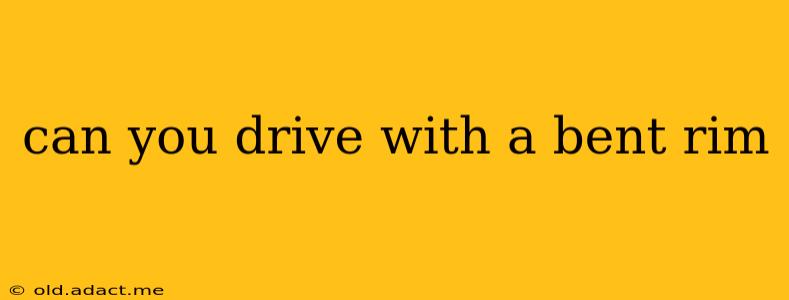Can You Drive with a Bent Rim? The Risks and Realities
Driving with a bent rim is a risky proposition, and the answer is a qualified no. While you might be able to drive a short distance on a slightly bent rim, doing so carries significant dangers to your vehicle, your safety, and the safety of others. This article explores the risks and helps you determine the best course of action if you suspect your rim is bent.
What Happens When You Drive on a Bent Rim?
A bent rim compromises the structural integrity of your wheel. This can lead to several serious problems:
- Tire Damage: The uneven surface of a bent rim puts uneven pressure on your tire. This can lead to premature and uneven tire wear, potentially causing a blowout. A sudden blowout at high speeds is incredibly dangerous.
- Vibration and Handling Issues: A bent rim causes your wheel to wobble, leading to noticeable vibrations in the steering wheel, chassis, and even the seats. This makes the vehicle difficult to control, especially at higher speeds. The handling becomes unpredictable and increases your risk of an accident.
- Suspension Damage: The constant jarring and vibrations from a bent rim can transmit stress throughout your suspension system. Over time, this can damage components like ball joints, tie rod ends, and even shock absorbers, leading to expensive repairs.
- Brake Problems: A bent rim can affect the alignment of your brake calipers and rotors, reducing braking efficiency and potentially leading to brake failure.
- Wheel Bearing Damage: The constant uneven stress on the wheel can damage the wheel bearings, leading to further mechanical issues and potentially a complete wheel failure.
How Can You Tell If Your Rim is Bent?
Several indicators suggest a bent rim:
- Visible Bending: Obvious bends or kinks in the rim are the clearest sign.
- Vibration: As mentioned above, vibrations in the steering wheel and chassis, especially at higher speeds, are a strong indicator.
- Tire Wear: Uneven or accelerated tire wear, particularly on one specific area of the tire, might point to a bent rim.
- Pulling to One Side: The vehicle might pull or drift to one side while driving, even after a wheel alignment.
How Far Can You Drive on a Bent Rim?
Driving any distance on a severely bent rim is strongly discouraged. A slightly bent rim might allow for a short, slow drive to a tire shop or mechanic, but even this is risky. Prioritize safety and limit your speed to a minimum. Avoid highways or fast roads.
What Should You Do If You Suspect a Bent Rim?
If you suspect you have a bent rim, do the following:
- Avoid Driving at High Speeds: Reduce your speed immediately and avoid aggressive driving maneuvers.
- Pull Over Safely: Find a safe place to pull over as soon as possible.
- Contact a Tire Professional: Call a tire shop or mechanic and explain the situation. They can assess the damage and advise on the best course of action.
- Avoid Further Damage: Do not attempt to straighten the rim yourself. This can worsen the damage and increase the risks.
Can You Repair a Bent Rim?
In some cases, a slightly bent rim might be repairable, but this depends on the severity of the damage. A professional will assess the rim and determine whether repair is feasible or if replacement is necessary.
In conclusion, while driving a short distance on a minorly bent rim might be possible, it is generally not recommended. The risks of serious damage to your vehicle and the potential for accidents significantly outweigh any perceived convenience. Prioritize safety and have your rim inspected by a professional as soon as possible.
